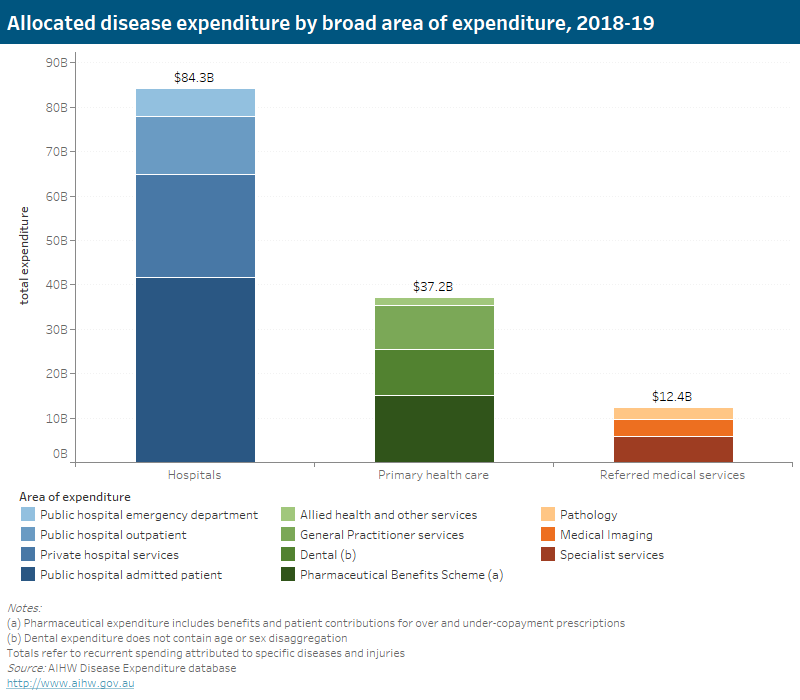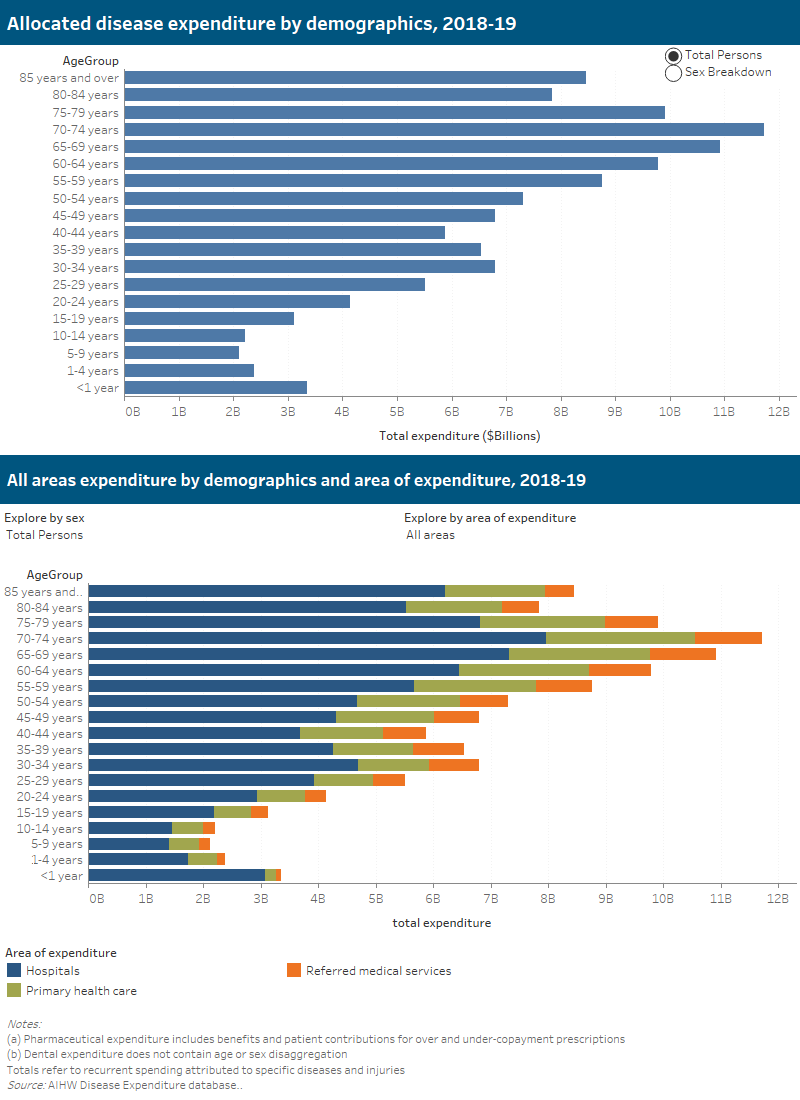Area of spending
The areas of spending in the disease expenditure analysis include hospital services, primary health care services and referred medical services (generally provided by medical specialists). Hospital services include public and private admitted patient services, public hospital emergency departments, and public hospital outpatient clinics. Primary health care includes general practitioner services, allied health services, pharmaceuticals and dental. Referred medical services include specialist services, medical imaging, and pathology.
Key points
In 2018–19:
- Total health spending was estimated at $195.4 billion, approximately $7,764 per person.
- Recurrent health spending, which is expenditure that does not result in the creation or acquisition of fixed assets (such as building hospitals), was $184.9 billion.
- For the purposes of this report, $134 billion, or 72% of recurrent spending, was able to be attributed to specific diseases and injuries.
- Approximately 63% of this allocated spending relates to hospital services, 28% related to primary health care, and 9% related to referred medical services, as opposed to these categories making up 40%, 34% and 10% of total spending respectively.
- The main gaps in allocated spending relate to primary health care where data on diagnosis in the national collections is limited.
Some components of recurrent expenditure are allocated differently between the health expenditure Australia database, and the disease expenditure study. This approach was taken to reflect patterns of healthcare use for particular conditions, which is the focus of this body of work, rather than health funding arrangements. For example:
- Public hospitals spending is further reported as emergency department, admitted patient, and outpatient clinic spending in this study.
- This study includes $1.4 billion of highly specialised PBS drugs dispensed in hospitals as PBS spending, while the health expenditure database reports this as hospital spending.
- Additionally, $6.6 billion of MBS services provided in hospitals as part of an admission are allocated to public and private hospitals, while this spending is reported as referred medical services in the health expenditure database.
For further information, please refer to Technical notes and the Disease Expenditure 2018–19 Study: Overview of analysis and methodology report.
Figure D1: Allocated disease expenditure by broad area of expenditure, 2018-19. This bar chart shows how disease expenditure was allocated by broad area of expenditure in 2018-19. Total disease expenditure in 2018-19 was AUS$134 billion, of which $84.3 billion, $37.2 billion, and $12.4 billion were allocated to hospitals, primary health care, and referred medical services, respectively. The main area of disease expenditure is public hospital admitted patient services ($42 billion, 31.12% of total), followed by private hospital services ($23 billion, 17.23%), and Pharmaceutical Benefits Scheme ($15 billion, 11.27%).

Allocated spending in each area varied according to age:
- Total spending generally increased with age for hospital admitted patient services, pathology and medical imaging.
- Emergency department and allied health spending were relatively steady across age groups.
- Spending on both the Pharmaceutical Benefits Scheme and medical specialist services generally increased substantially with age
These patterns of disease spending by age varied, however, according to sex:
- For males, the bulk of spending tends to occur later in life.
- Spending for females between the ages of 20 to 45 is substantially higher than males, largely due to spending on maternal conditions.
The following interactive data visualisations can be used to display health spending by age and sex, for each area of expenditure. Data used to create the visualisations can also be downloaded as an Excel workbook.
Figure D2: Allocated disease expenditure by demographics and area of expenditure, 2018-19. This bar chart shows how disease expenditure was allocated by demographics and area of expenditure in 2018-19. Allocated spending in each area varied across age, where total spending generally increased with age for hospital admitted patient services, while emergency department was relatively steady with age. These patterns of disease spending also differed across age; however, the bulk of spending tends to occur later in life, regardless of sex.



